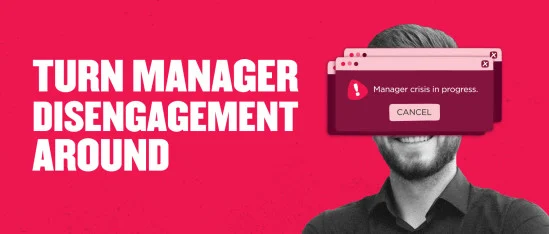Your managers are the engine that powers your people strategy. And right now, it’s stalling.
We talk a lot about quiet quitting among team members. But what happens when the ones quietly checking out are the people leading those teams—your managers?
These are the people who shape engagement, connect strategy to execution, and make or break team culture. They don’t just manage work. They shape how people experience it.
According to Gallup, only 27 percent of managers are engaged at work—a startling stat when you consider that managers influence 70 percent of team engagement.
In other words, disengaged managers don’t burn out on their own. They have the potential to bring their teams down with them.
And yet, most organizations aren’t noticing this slow fizzle.
The early signs are subtle. No big resignation letters, no dramatic departures, no big speeches. Just a growing sense of disconnection.
It costs more than just morale. That same Gallup report states that a staggering $9.6 trillion in productivity would be added to the economy if the global workforce were fully engaged.
It’s a crisis that’s hiding in plain sight, and it’s exactly where HR teams can step in and lead from the front.
The hidden cost of manager disengagement
Disengaged managers might not always raise red flags, but you can spot those flags easily if you know where to look.
When managers start to disconnect, the effects can ripple outward through your teams and impact key areas like communication and culture. This isn’t about pointing fingers. It’s about spotting the signals early and stepping in with support.
Here’s what to look out for:
- Morale takes a hit. Managers are your organization’s culture carriers. When they pull back, recognition slows, communication gets patchy, and trust can fade.
- Performance stalls. Without regular coaching and feedback, team growth can plateau.
- Attrition rises. When people feel unsupported or unrecognized, they quietly look elsewhere. If managers check out, your top performers might quietly follow their lead.
The companies pulling ahead are those that build their productivity through trust, flexibility, and modern leadership, not pressure or micromanagement.
Empowered managers are key to realizing that future.
Why are managers quietly quitting?
People often assume disengagement is about apathy. In reality, it’s a quiet response to feeling overextended or under-supported.
For managers, the stakes are even higher. These are the people your teams rely on for clarity, energy, and direction. But without the right support structures in place, even the most capable managers can lose momentum over time.
The key to understanding the root of managers’ disengagement lies in understanding why it happens and how HR can create the conditions for them to thrive.
Common issues that managers face include:
- Unbalanced expectations. Managers are juggling hybrid teams, change fatigue, and increasing demands—often without the support or clarity they need to tackle these challenges head-on.
- Limited development opportunities. Many managers don’t have a roadmap. They’ve got a title, a team, and a to-do list, but not the tools or training to succeed and move forward in their own careers.
- Disconnected systems. Manual processes and siloed data slow everything down. Instead of leading and strategizing, managers spend time chasing approvals or reworking workflows.
- Low visibility and recognition. Managers give a lot. But when their contributions go unseen, motivation takes a hit. What looks like quiet quitting is often something more human, a signal that something’s missing.
HR empowers the enablers
Now that we understand the problem, what can we do to fix it?
This is where HR can step up and truly shine. When HR prioritizes manager enablement, the impact is exponential. Engagement lifts, culture strengthens, and performance follows.
Here’s how you can help move your managers away from burnout.
1. Start with listening
Performance challenges often stem from people-related issues, and behind those are blockers.
Listening is always step one, but trust is built on action. Start by finding out what your managers actually need, then act on what you hear. Active listening is key to uncovering what’s working and what roadblocks may be in the way.
That might include:
- Unclear priorities. Managers need clarity on where to focus their time and energy, especially in fast-moving, hybrid environments.
- Admin overload. Too much time spent on manual tasks leaves little space for coaching, strategy, or people leadership.
- A need for more feedback or recognition. Without input or acknowledgement, it’s hard for managers to grow or stay motivated.
You can also use pulse surveys or small group sessions to help generate insights and then act on them with full transparency.
2. Redefine recognition
Recognition isn’t just for individual contributors. Managers also need to feel seen, heard, valued, and appreciated.
It’s important to highlight not just the outcomes, but the leadership behaviors that drive them:
- Supporting team growth. Recognize managers who develop their people and champion learning.
- Leading through change. Call out those who guide teams with steadiness and adaptability during uncertain times.
- Fostering collaboration. Acknowledge the leaders who break down silos and strengthen team alignment.
- Building inclusive cultures. Celebrate managers who lead with empathy and create space for every voice.
You can use shoutouts and leadership spotlights to share these wins company-wide.
3. Equip them to lead, not just manage
Disengagement often stems from stagnation—a sense that there’s no clear next step. So give your managers the room, resources, and encouragement to grow into their full potential.
That includes:
- Practical tools. Things like coaching guides, goal-setting templates, and alignment frameworks.
- Clear success metrics. Define what effective leadership looks like in your organization so managers can align and grow with purpose.
- Peer learning. Manager roundtables and internal communities help to build shared experience, connection, and problem-solving support.
Great leadership doesn’t happen by accident. It’s nurtured, supported, and built over time. And when managers grow, so do their teams.
4. Automate what slows them down
Admin work costs so much more than just time. It drains energy and focus. When managers are buried in busywork, it’s harder for them to lead with clarity and intent.
Automation helps lift that burden.
From onboarding to feedback loops, intuitive workflows and smart people systems can reduce the noise and pinpoint the data that really matters—and streamline the rest.
Time saved is energy reclaimed and better spent supporting people.
5. Bake wellbeing into the manager experience
Managers set the tone. If they’re stretched too thin, it’s hard for anyone to thrive.
Build wellbeing into their everyday experience with:
- Flexibility and autonomy. Give managers space to structure their time and focus in ways that suit their teams.
- Human-centered check-ins. Make sure to ask, “How are you?” not just, “How’s delivery?” These personal check-ins do a lot to build trust and psychological safety.
- Balanced goals. Measure success by outcomes and culture, not just KPIs.
When managers feel supported, they lead with empathy and energy.
6. Give them data that drives impact
Managers want to make smart decisions. Help them do it with meaningful, actionable insights.
With centralized dashboards and real-time sentiment data, managers can:
- Spot disengagement early. Spot the early signs of dipping motivation in their teams so they can act before it hits performance or retention.
- Understand team dynamics. See how communication, collaboration, and engagement vary across teams to tailor support.
- Measure the impact of recognition or feedback. Track how small changes in leadership behavior influence team morale.
- Plan development conversations around real needs. Use insights to make career conversations more relevant, personalized, and productive.
Confidence comes from clarity, and that always starts with great data.
Recommended For Further Reading
What great manager enablement looks like
So what happens when HR makes the shift from reacting to quiet quitting to proactively supporting managers?
The impact is immediate and long-term:
- Profitability rises. Gallup found that highly engaged teams see a 23 percent rise in profitability.
- Team dynamics improve. More engaged managers mean stronger team morale, fewer absences, and greater ownership across the board.
- Career development accelerates. Internal mobility and succession planning improve because managers feel equipped and motivated to grow their careers—and others’.
- HR initiatives gain momentum. Engaged managers become advocates, not bottlenecks, helping make sure your people programs land with true impact.
In other words, when manager enablement becomes a core principle of your culture, everything gets that much easier.
That’s the real ROI of putting people managers first.
Turning the tide on quiet quitting
Re-engaging your managers is all about getting real, lasting value across your business.
When managers feel supported and confident, they amplify what’s already working: They build stronger teams, shape culture with intention, and help HR initiatives land with greater impact.
Even small shifts—clearer expectations, better tools, timely recognition—can lead to big improvements in performance, retention, and morale.
The best part? This isn’t a massive transformation. It’s a mindset shift and a culture change. It’s about equipping your managers with the tools, data, and trust they need to lead with purpose.
So pause and picture your organization: What would it look like if every manager felt confident, connected, and valued?
Now’s the time to find out.


